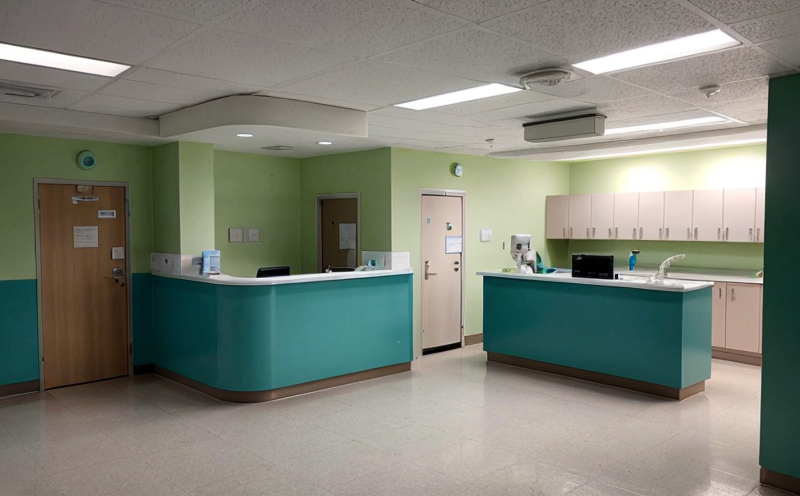WHO Mold and Fungal Contamination Testing in Hospitals
The World Health Organization (WHO) guidelines emphasize the importance of maintaining a hygienic environment to ensure patient safety. In healthcare settings, mold and fungal contamination can pose significant health risks, particularly for immunocompromised patients. This service focuses on conducting comprehensive mold and fungal contamination testing in hospitals, adhering to WHO recommendations and international standards such as ISO 14644-1 and EN ISO 17853.
Mold and fungi thrive in warm, humid environments, making healthcare facilities prone to these contaminants. The presence of molds like Aspergillus, Candida, or Penicillium can lead to opportunistic infections among vulnerable patient populations. Therefore, proactive monitoring and remediation are crucial for maintaining a safe environment.
The testing process involves collecting air samples using specialized sampling devices that capture viable particles. These samples are then analyzed in our accredited laboratories using advanced techniques such as culture-based methods, quantitative polymerase chain reaction (qPCR), and DNA sequencing. This multi-method approach ensures accurate identification of mold species present in the environment.
Our laboratory adheres strictly to WHO protocols for sample collection and processing. For instance, we recommend a minimum of 10 sampling points per facility to cover various areas including patient rooms, waiting areas, and staff lounges. Samples are transported under controlled conditions to prevent any contamination or spoilage during transit.
The analysis process includes not only identifying the types of molds present but also quantifying their concentration levels. This information is vital for understanding the extent of contamination and guiding appropriate remediation efforts. Our reports provide detailed insights into the microbial load, species distribution, and potential health impacts based on WHO guidelines.
Compliance with these tests is not only essential from a regulatory standpoint but also critical for maintaining patient trust and satisfaction. Hospitals that demonstrate proactive measures in addressing mold and fungal issues can enhance their reputation as safe and reliable healthcare providers.
In summary, our WHO Mold and Fungal Contamination Testing service offers a comprehensive approach to ensuring hospital environments meet the highest hygiene standards recommended by WHO. By leveraging cutting-edge technology and rigorous adherence to international protocols, we help healthcare facilities mitigate risks associated with mold and fungal contamination effectively.
Quality and Reliability Assurance
Our commitment to quality extends beyond just conducting tests; it encompasses every aspect of our operations. We employ experienced microbiologists who have extensive knowledge in environmental sampling techniques and analysis methodologies. Our team members undergo continuous training to stay updated with the latest developments in the field.
The equipment used for mold and fungal testing is calibrated regularly and maintained according to manufacturer specifications to ensure accurate results. We follow strict quality control procedures at every stage of the process, from sample collection to final report generation. This includes using standardized protocols recommended by WHO and other relevant bodies like EPA (Environmental Protection Agency).
Our laboratory is accredited under ISO/IEC 17025:2017 standards, which ensures that our testing processes meet internationally recognized criteria for technical competence. Regular internal audits are conducted to evaluate compliance with these standards and identify opportunities for improvement.
We also maintain robust data management systems to track all aspects of the testing process, ensuring transparency and traceability throughout each project. This helps us maintain high levels of reliability in our reports while facilitating efficient communication between clients and laboratory staff.
By integrating advanced analytical tools with traditional methods, we provide reliable and actionable insights that enable healthcare facilities to make informed decisions regarding their indoor air quality management programs.
International Acceptance and Recognition
- ISO/IEC 17025:2017 Accreditation: Our laboratory is fully accredited under this international standard, ensuring that all our testing procedures meet the highest quality assurance criteria.
- EPA Compliance: We adhere to Environmental Protection Agency guidelines for mold and fungal contamination testing, providing results that are widely accepted across North America.
- EN ISO 17853-1: Our methods align with European standards for assessing airborne fungal spores in indoor environments.
- ASTM E2694: We utilize this American Society for Testing and Materials standard when performing mold contamination assessments.
- WHO Guidelines: All our testing protocols are designed to comply strictly with World Health Organization recommendations, ensuring consistency with global best practices.
Our international recognition ensures that the results from our tests are valid not just within national borders but internationally as well. This broad acceptance enhances confidence among stakeholders who rely on our services for decision-making purposes related to hospital hygiene and safety.
Environmental and Sustainability Contributions
Mold and fungal contamination testing plays a crucial role in promoting environmental sustainability by helping healthcare institutions identify sources of indoor air pollution early. By addressing these issues promptly, we contribute positively towards reducing energy consumption required for ventilation systems and improving overall building efficiency.
The identification of specific mold species allows targeted interventions such as source removal rather than blanket disinfection practices which can be less effective or even harmful if not done correctly. This approach reduces the need for frequent retesting cycles, thereby minimizing unnecessary resource usage.
Furthermore, by maintaining cleaner indoor environments through regular monitoring and remediation efforts, we help reduce healthcare-associated infections (HAIs), ultimately leading to lower readmission rates and shorter hospital stays. These outcomes translate into significant cost savings for both patients and providers alike.
In conclusion, our WHO Mold and Fungal Contamination Testing service contributes significantly towards creating healthier indoor environments while supporting broader sustainability goals within the healthcare sector.





